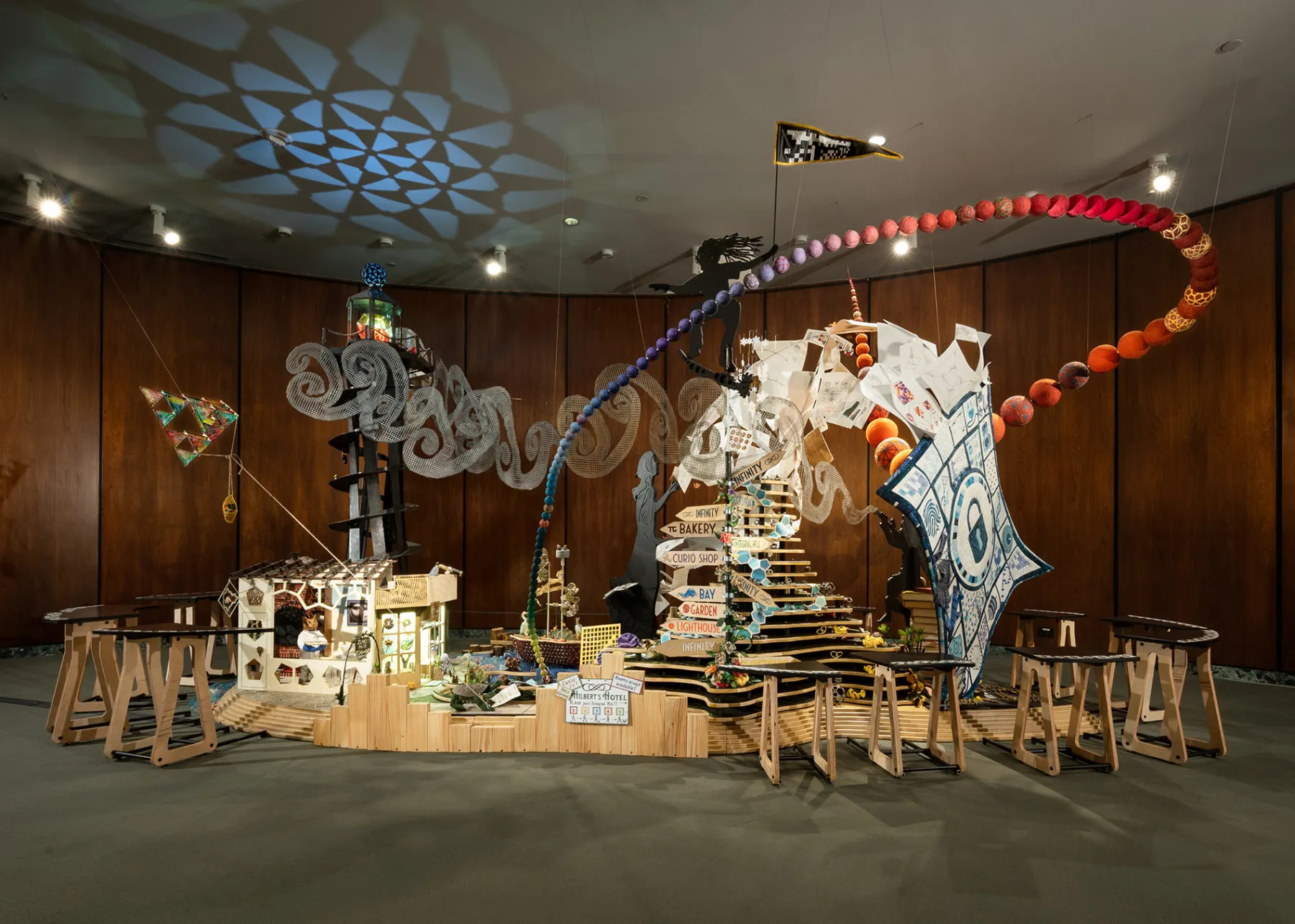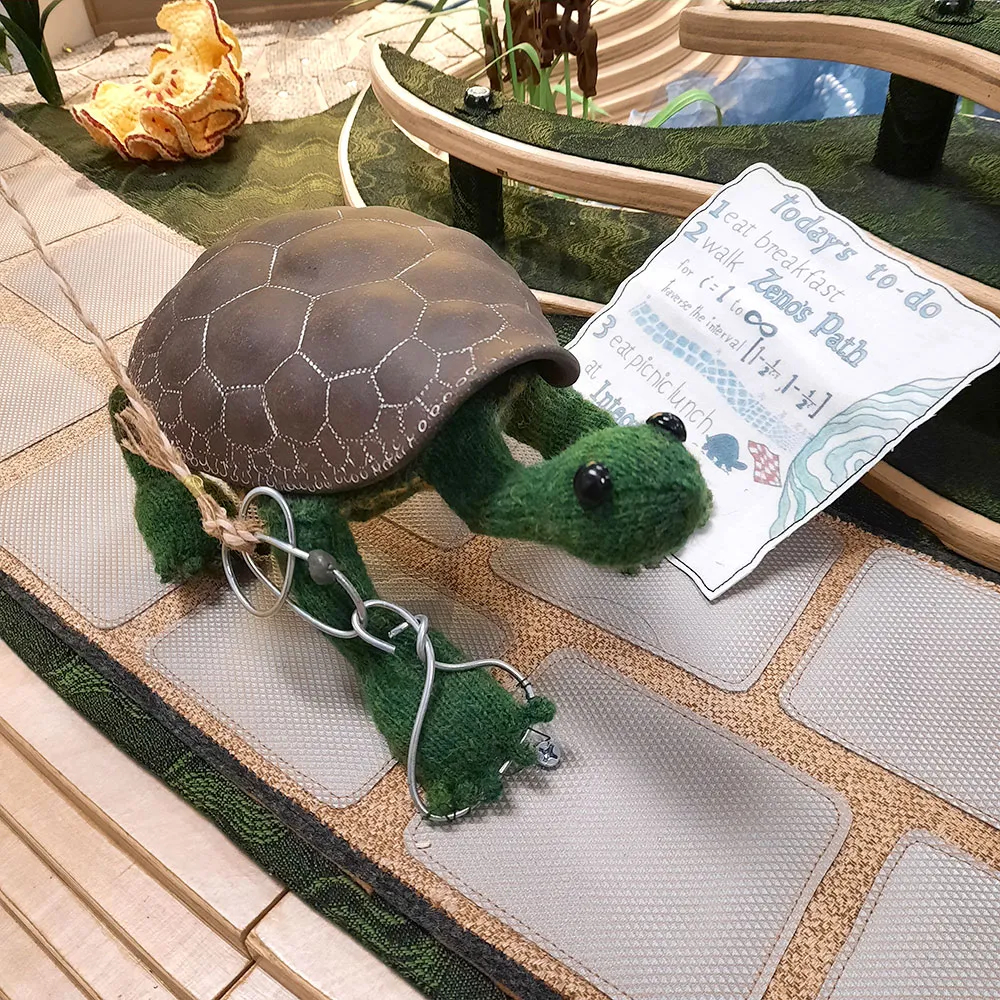(Math + Art) × Fun = Mathemalchemy!
The inside scoop on a mathematics fever dream turned artistic playground for all math lovers (and haters too)
Gayoung Lee • March 15, 2024

A playful alchemy of math, art and creative storytelling has become a full-blown art exhibition called Mathemalchemy [Credit: Kevin Allen | Mathemalchemy]
Boredom under COVID quarantine led many to pursue some strange side hobby, but for 24 mathematicians and artists, it resulted in Mathemalchemy — a collective of mathematically (aesthetically, too) charming pieces of art — from cryptographic quilts, huge parabolas of embroidered spheres, crochet theta curves caught in fishing nets and murals of OctoPi, seen generating various wave-related equations per every water ripple.

Every part of Mathemalchemy harbors a unique story, including Tess the Tortoise’s journey to learn about infinity [Credit: Elizabeth Paley | Mathemalchemy]
For the “Mathemalchemists,” their project is a lively, whimsical invitation into the world of mathematics, made for an audience of all ages and interests. The goal is to illustrate how math can be fun — not something schools force you to do, but something that leaves you inspired.
So, how did this project come to be? What makes Mathemalchemy so special, both for the Mathemalchemists and anyone that comes across the exhibition? In this podcast, Gayoung Lee goes behind the scenes of Mathemalchemy with co-founders Ingrid Daubechies and Dominique Ehrmann, in addition to Mathemalchemists Jessica Sklar, Elizabeth Paley and Carolyn Yackel.
You can also listen to this episode on Apple Podcasts, Spotify or Stitcher.
(Intro music) Jenaye Johnson: Hey there. Welcome back to the Scienceline podcast. I’m Jenaye Johnson, your host and the Multimedia Editor here at Scienceline.org. Make sure to subscribe to our show — whether that’s on Apple Podcasts, Spotify, Stitcher or another platform that you prefer using. Jenaye Johnson: What’s in store for today’s episode? Well, let’s just say if you love math, you’ll want to hear this one out. If you enjoy quirky, somewhat trippy art, you’ll also wanna stay tuned. Not a fan of either? You will be after listening to this Mathemalchemy story! Jenaye Johnson: I’ll let Gayoung Lee take it away. (Music starts) Gayoung Lee: Think back to, say, May 2020. It’s been two months since COVID shut down practically everything outside. We’re all home. And there’s only so much we can do to entertain ourselves with books or TV shows or whatever we used to do in our free time before all this happened. For many of us, that meant pursuing a random side hobby, like crochet, dance, baking, or all kinds of DIY crafts. Gayoung Lee: But for a group of mathematicians plus one fabric artist, crafting during quarantine resulted in 24 pieces of art. It was all informed and inspired by math. Gayoung Lee: Every part of Mathemalchemy harbors a unique story, from cryptographic quilts, huge parabolas of embroidered spheres, and murals of OctoPi — that’s spelled P-I, by the way, as in the math symbol — seen generating various wave-related equations per every water ripple. Gayoung Lee: So an interesting sculpture, plus some math, and together a fascinating invitation into the imaginative world of what math can be. Gayoung Lee: My name is Gayoung Lee. And today, I’d like to take you behind the scenes of Mathemalchemy. Gayoung Lee: Mathemalchemy was founded by one mathematician and one artist: Ingrid Daubechies and Dominique Ehrmann. Dominique can pinpoint an exact birthday for the project. EHRMANN: September 2, 2019. This is a conversation Ingrid and I had a lot — to change the perception that math is hard. Math is not fun. Math is something that you need to do, but you never wish to do. Gayoung Lee: Here’s Ingrid. DAUBECHIES: I had this vision of a story being told, but the objects in it being these beautiful mathematical objects, and the whole installation, not just being a story, but also a celebration of mathematics. Gayoung Lee: Their first stop: Denver, Colorado, where the annual Joint Mathematics Meeting was to be held. The goal: recruit some mathematicians to create some art. By the end, they had twenty-four Mathemalchemists, who would attend three workshops to come up with story ideas and to create artwork, using various materials like yarn, fabric, ceramic and metal. But just one small problem. The conference in Denver was held in the second week of January 2020. And we all know what happened next. [Crossfade of soundbites: WHO pandemic declaration, news anchor announcing quarantine] DAUBECHIES: So… the first workshop had been scheduled for the third week of March in 2020. LEE: Oh. [LEE and EHRMANN laugh uncomfortably] DAUBECHIES: And so clearly, as we came closer, people said “Will it happen? Will it not?” Then everything shut down. It was clear. There was no decision to be taken. EHRMANN: And that changed completely the way we’d planned to build it. DAUBECHIES: So that’s when we learned Zoom. Gayoung Lee: The pandemic gave Mathemalchemists more time to really delve into the storytelling behind each piece. Take, for instance, Tess the Tortoise, a crochet tortoise with a ceramic shell, walking down “Zeno’s path.” Gayoung Lee: Tess’s story is about infinity. For example, her name comes from the word “tessellation,” which in math refers to a tile of repeating patterns on a surface. In this case, the surface is the shell. And Tess’s shell is a tessellation of heptagons, a polygon with seven sides. Mathemalchemists Jessica Sklar and Elizabeth Paley recall the story behind Tess. Gayoung Lee: Jessica says, SKLAR: One day Tess the Tortoise wakes up and decides she’s going to go on a journey and learn about infinity. Gayoung Lee: Jessica, an abstract mathematician by practice, first came up with a story based on the math concept called Zeno’s paradox. SKLAR: Zeno’s path is this idea that, Zeno’s paradox — let’s say you want to get from point A to point B. And to get there, you have to walk half the distance, right? So you walk half the distance. Okay, then you’re halfway there, and then you have to walk half the remaining distance. So you walk half the distance, and then a fourth, and you have to walk half the remaining distance, which is an eighth. And the paradox being that if you’re always doing half of what remains, you’re never going to get there. But of course you…do (laughs). Gayoung Lee: And Elizabeth, an engineering professor who also happens to be a ceramic artist with her own kiln, created Tess’s shell to illustrate Zeno’s paradox, using the shape of heptagons on the shell. PALEY: So with the shell, the shell was pretty straightforward. It was the first piece I had made for Mathemalchemy. I knew enough about turtle shells and tortoise shells to have a sense that there would be some sort of tessellation, some sort of geometry, geometric design on the shell. Gayoung Lee: As the Mathemalchemists continued to collaborate, they found themselves having whimsical conversations about the backstories. For Tess, there was a very, very important issue. SKLAR: I don’t know why we were all really committed to Tess having lunch with her. DAUBECHIES: And at first she had a backpack and I said, “The backpack, we can’t have a backpack because it’s such a beautiful shell. It has this heptagonal tiling and so on.” Okay, so then she was going to pull a cart. But then we had a problem… EHRMANN: …She was not comfortable with the cart. DAUBECHIES: Yeah! How would she pull the cart? It was going to hurt her, and her neck! [EHRMANN and DAUBECHIES laugh] EHRMANN: We went very far with our conversations. DAUBECHIES: And somebody says, “Do you realize you’re talking about whether a cart will hurt a turtle that’s knitted and stuffed, with ceramics?” Gayoung Lee: Elizabeth sees it like this: PALEY: I think the animals in Mathemalchemy kind of help to bridge our world with mathematics. Everybody loves a good story. Gayoung Lee: These conversations continued for over eighteen months, until all the pieces and Mathemalchemists met for the first time, in person, on July 2021, at Duke University. After that, once everything was finished, every Mathemalchemist, their family and community guests held a big farewell party at Duke before Mathemalchemy’s first big reveal to the public. Gayoung Lee: Dominique remembers that first time. EHRMANN: The installation was first seen at the Academy of Science in Washington. We had Ingrid at the annual meeting with all those very important scientists and mathematicians and physicists, and they were… so… joyful! They got it. They were laughing, they were exchanging information. They were having fun around that piece. And I said, “Okay. We have something.” Gayoung Lee: Since then, Mathemalchemy has been traveling all over the United States, and even over the border to Canada. EHRMANN: Every time we have our new venues and there’s a lot of kids coming. So their reaction is quite strong when they’re near the piece. They just didn’t stop talking. Gayoung Lee: The long-term goal is to have the exhibition permanently stationed at a museum, but for now Mathemalchemy is still on tour. By holding exhibitions at universities, the co-founders hope that their brainchild will also inspire the next generation of creative storytellers in the field of mathematics. Sometimes, even mathematicians themselves don’t realize how creative they can be. Just ask another Mathemalchemist, Carolyn Yackel. YACKEL: I feel like it leveled up my art. Now I feel okay presenting my art as art, instead of just some kind of weird craft thing. Gayoung Lee: And that’s just one part of what makes Ingrid so excited about Mathemalchemy. DAUBECHIES: We want to counter the perception that some people have of mathematics as this very complicated but incomprehensible thing for which you have to have a special gift or otherwise forget about understanding anything. I mean, mathematicians don’t believe that mathematics is that and we always want to show that mathematics is much more alive and interesting and wonderful. (Outro music fades in) Jenaye Johnson: And that wraps it up. Thanks for listening! Feel free to share this story with family or friends or anyone you think might be interested. The Scienceline podcast is available on every major platform, so be sure to subscribe wherever you listen. Oh, and if you’d like, maybe give us a rating or review. It helps other people to find our show. Jenaye Johnson: Scienceline is a production of NYU’s Science, Health and Environmental Reporting Program. Our theme music is by Jahzzar at the Free Music Archive. And for more information, please visit us at Scienceline.org or shoot us an email at scienceline@gmail.com. See you next time! (Outro music fades out)
MUSIC:
“Pglet Into” by Blue Dot Sessions | CC BY-NC 4.0